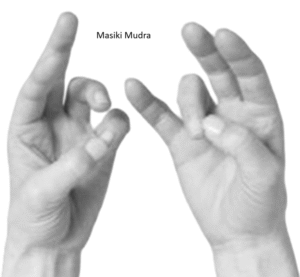Māsikī Mudrā
Introduction
Māsikī Mudrā is a relatively less-known but significant yogic gesture found in the Tantric and Hatha Yoga traditions. It is linked with the regulation of lunar energy (chandra tattva) and the cyclical rhythms of the body, particularly those associated with the female reproductive system and the soma principle (nectar energy).
The mudra is often practiced in conjunction with pranayama and meditation, especially during sādhanās focused on cooling, balancing, and harmonizing inner energies.
Meaning
Māsikī comes from the Sanskrit word Māsa = “month” or “lunar cycle”.
It represents monthly cyclic energy, the rhythms of time, moon, and menstruation.
Mudra = “gesture” or “seal”.
Thus, Māsikī Mudrā can be understood as the gesture that harmonizes with the monthly rhythm of lunar energy, balancing feminine and cooling forces in the body.
How to Perform (Practice)
Sit in Padmasana, Siddhasana, or Sukhasana with a straight spine.
Each hand does something different
Right hand – bring the thumb tip to the inside of the nail on your ring finger.
Left hand – bring the tips of your thumb and little finger together.
Focus on the swadhisthana chakra (sacral energy center) and/or ajna chakra (third eye).
Practice for 10–15 minutes in the evening or during meditation.
Benefits
Physical Benefits
Balances menstrual cycles and alleviates discomfort.
Cools down excess heat and pitta in the body.
Supports reproductive health and hormonal balance.
Relieves fatigue, insomnia, and stress-related physical disorders.
Improves digestion by calming the fire element.
Energetic Benefits
Activates the lunar (ida nadi), enhancing calmness and cooling energy.
Strengthens connection with soma (amrita, nectar energy).
Enhances fluid balance in tissues (linked with water element).
Helps in deep meditative states and pratyahara (withdrawal of senses).
Mental & Spiritual Benefits
Promotes emotional stability and tranquility.
Reduces stress, anxiety, and irritability.
Enhances intuition and inner awareness.
Helps harmonize with lunar phases, supporting spiritual practices aligned with the moon.
Contraindications
Avoid during severe depression or extreme lethargy (as it may enhance heaviness).
Not recommended for those with excess kapha dosha (as it may increase sluggishness).
Should not be practiced immediately after heavy meals.
Pregnant women should practice under guidance.
Anatomy & Physiology
Stimulates parasympathetic nervous system, reducing heart rate and cooling the body.
Activates swadhisthana chakra, regulating reproductive and urinary functions.
Engages hand marma points that connect to reproductive and endocrine systems.
Balances water metabolism and supports hormonal regulation.
Kinesiology
Involves opposition of thumb, ring, and little finger tips, engaging muscles like flexor pollicis longus, flexor digitorum profundus, and interossei muscles.
Extended index and middle fingers lengthen finger flexors and stabilize hand position.
Improves fine motor control and neural feedback through sensory stimulation of fingertips.
Neurology
Stimulates sensory nerves in fingers connected with vagus nerve activity.
Enhances neuroendocrine regulation, particularly linked to hypothalamic-pituitary-ovarian axis.
Induces a relaxation response, calming overactive sympathetic nervous system.
May support neuroplasticity by conditioning the brain toward calm states.
Duration of Practice
Beginners: 5–10 minutes daily.
Intermediate: 15–20 minutes daily.
Advanced practitioners: Up to 30 minutes in deep meditation.
Best practiced during evening, full moon days, or when feeling overheated or restless.
Counter Mudra
Surya Mudra (Sun Gesture) – to balance if too much cooling or lethargy arises.
Prana Mudra – to re-energize after long lunar meditative practices.
Apana Mudra – to assist if digestive sluggishness occurs.
Conclusion
Māsikī Mudrā is a lunar and cyclical energy gesture that harmonizes the rhythms of body and mind with the moon’s influence. It helps regulate menstrual cycles, cools excess heat, and calms the mind. When practiced regularly, it supports emotional stability, reproductive health, and deeper meditation, making it especially valuable for women and for those seeking balance with lunar energy.
FAQ
Q1. Is Māsikī Mudrā only for women?
No, while it supports menstrual health, men can also practice it for lunar cooling and mental calmness.
Q2. When is the best time to practice it?
During evening meditation, full moon days, or when seeking to reduce heat and restlessness.
Q3. Can it be combined with pranayama?
Yes, it works well with Chandra Bhedana Pranayama (left-nostril breathing) or Sheetali/Sheetkari Pranayama.
Q4. Does it help with anxiety?
Yes, it strongly activates ida nadi, which reduces overthinking and stress.
Q5. How soon can results be felt?
Some effects (calmness, cooling) can be felt immediately, while hormonal and menstrual balance may take weeks of consistent practice.
References
Swami Satyananda Saraswati – Asana, Pranayama, Mudra, Bandha.
Gertrud Hirschi – Mudras: Yoga in Your Hands.
Vasant Lad – Ayurveda: Science of Self-Healing.
Dr. David Frawley – Yoga and Ayurveda.
Research journals on mudras and lunar energy regulation.

